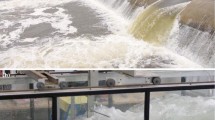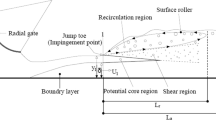Abstract
The flow structure in a steady hydraulic jump in both the non-aerated and aerated regions was measured using the image-based particle image velocimetry and bubble image velocimetry techniques, respectively. Three highly aerated steady jumps with Froude numbers varying from 4.51 to 5.35 were tested, and a weak jump with a Froude number of 2.43 was generated for comparison. Mean velocities and turbulence statistics were obtained by ensemble averaging the repeated velocity measurements. Based on the mean velocities, the flow structure in the steady jumps was classified into four regions to distinguish their distinct flow behaviors; they are the potential core region, the boundary layer region, the mixing layer region, and the recirculation region. The flow structure in the weak jump features only three regions without the recirculation region. In addition, spatial variations of mean velocities, turbulence intensity, and Reynolds stresses were also presented. It was observed that the maximum horizontal bubble velocity and maximum horizontal water velocity occur at the same location in the overlapping regions of potential core and mixing layer. The ratio between the maximum horizontal bubble velocity and maximum horizontal water velocity is between 0.6 and 0.8, depending on the Froude number. Examining the mean horizontal bubble velocities in the mixing layer, a similarity profile was revealed with representative mixing layer thickness as the characteristic length scale and the difference between the maximum positive and maximum negative velocities as the characteristic velocity scale. It was also found that the mean horizontal water velocities in the near-wall region are self-similar and behave like a wall jet. Further analyzing autocorrelation functions and energy spectra of the water and bubble velocity fluctuations found that the energy spectra in the water region follow the −5/3 slope, whereas the spectra in the bubble region follow a −2/5 slope. In addition, the integral length scale of bubbles is one order of magnitude shorter than that of water.























Similar content being viewed by others
Abbreviations
- b :
-
Half-width of mixing layer for bubble velocity (L)
- b w :
-
Half-width of wall jet for water velocity (L)
- C i :
-
Regression coefficients, i = 0–5
- F r :
-
Approaching inflow Froude number, \( u_{1} /\sqrt {gy_{1} } \)
- F B :
-
Froude number determined by Belanger equation, \( y_{2} /y_{1} = 0.5\left( { - 1 + \sqrt {1 + 8F_{B}^{2} } } \right) \)
- g :
-
Gravitational acceleration (LT−2)
- I :
-
In-plane (equivalent) turbulence intensity, \( \sqrt {\overline{{u^{\prime 2} }} + \overline{{v^{\prime 2} }} } /u_{1} \)
- q :
-
Unit-width discharge (L2T)
- Re :
-
Reynolds number, u 1.y 1/ν
- r :
-
Ratio between maximum bubble velocity and maximum water velocity
- t :
-
Time (T)
- U rms :
-
Horizontal turbulence level,\( \sqrt {\overline{{u^{\prime 2} }} } /u_{1} \)
- u :
-
Mean horizontal velocity (LT−1)
- u 1 :
-
Average approaching velocity (LT−1)
- u max :
-
Maximum positive horizontal velocity (LT−1)
- u min :
-
Maximum negative horizontal velocity (LT−1)
- u′:
-
Horizontal velocity fluctuations (LT−1)
- V rms :
-
Vertical turbulence level,\( \sqrt {\overline{{v^{\prime 2} }} } /u_{1} \)
- v :
-
Mean vertical velocity (LT−1)
- v′:
-
Vertical velocity fluctuations (LT−1)
- X :
-
Horizontal distance from the sluice gate (L)
- \( \tilde{X} \) :
-
Horizontal distance from air bubble release (L)
- x :
-
Horizontal distance from the toe of jump (L)
- Y :
-
Vertical distance from the flume bed (L)
- y :
-
Vertical distance from the flume bed (L)
- y 1 :
-
Pre-jump depth (L)
- y 2 :
-
Post-jump depth (L)
- y max :
-
Vertical position of u max for water (L)
- y umax :
-
Vertical position of u max for bubbles (L)
- y umin :
-
Vertical position of u min for bubbles (L)
- Λ:
-
(Equivalent) Reynolds stresses, \( - \overline{{u^{\prime } v^{\prime } }} /u_{1}^{2} \)
- ρ:
-
Mass density (ML−3)
- ν:
-
Kinematic viscosity of water (L2T−1)
References
Bakhmeteff BA, Matzke AE (1935) The hydraulic jump in terms of dynamic similarity. Trans Am Soc Civ Eng 101:630–680
Bryant DB, Seol DG, Socolofsky SA (2009) Quantification of turbulence properties in bubble plumes using vortex identification methods. Phys Fluids 21:075101
Chang K-A, Lim H-J, Su CB (2003) Fiber optic reflectometer for velocity and fraction ratio measurements in multiphase flows. Rev Sci Instrum 74:3559–3565
Chang K-A, Ariyarathne K, Mercier R (2011) Three-dimensional green water velocity on a model structure. Exp Fluids. doi:10.1007/s00348-011-1051-0
Chanson H (2007) Hydraulic jumps: bubbles and bores. In: Proceedings of 16th Australasian fluid mechanic conference, Gold Coast, Australia, pp 39–53
Chanson H (2011) Bubbly two-phase flow in hydraulic jumps at large Froude numbers. J Hydraul Eng 137:451–460
Chanson H, Brattberg T (2000) Experimental study of the air-water shear flow in a hydraulic jump. Int J Multiph Flow 26(4):583–607
Chow VT (1973) Open channel hydraulics. The McGraw-Hill Book Co. Inc., Singapore
Hager WH (1992) Energy dissipators and hydraulic jump. Kluwer, The Netherlands
Hornung HG, Willert C, Turner S (1995) The flow field downstream of a hydraulic jump. J Fluid Mech 287:299–316
Hoyt JW, Sellin RHJ (1989) Hydraulic jump as mixing layer. J Hydraul Eng 115(12):1607–1614
Keane RD, Adrian RJ (1992) Theory of cross-correlation analysis of PIV images. Appl Sci Res 49:191–215
Lennon JM, Hill DF (2006) Particle image velocity measurements of undular and hydraulic jumps. J Hydraul Eng 132(12):1283–1294
Leutheusser HJ, Kartha VC (1972) Effects of inflow condition on hydraulic jump. J Hydraul Div Am Soc Civ Eng 98(8):1367–1384
Lin C, Hwung WY, Hsieh SC, Chang KA (2007) Experimental study on mean velocity characteristics of flow over vertical drop. J Hydraul Res 45(1):33–42
Lin C, Hsieh SC, Kuo KJ, Chang KA (2008) Periodic oscillation caused by a uniform flow over a vertical drop energy dissipater. J Hydraul Eng 134:948–960
Liu M, Rajaratnam N, Zhu D (2004) Turbulence structure of hydraulic jumps of low Froude numbers. J Hydraul Eng 130(6):511–520
Long D, Steffler P, Rajaratnam N (1990) LDA study of flow structure in submerged hydraulic jump. J Hydraul Res 28(4):437–460
Long DJ, Rajaratnam N, Steffler PM, Smy PR (1991) Structure of flow in hydraulic jumps. J Hydraul Res 29(2):207–218
Mehrotra SC (1976) Length of hydraulic jump. J Hydraul Div Am Soc Civ Eng 102(7):1027–1033
Misra SK, Kirby JT, Brocchini M, Veron F, Thomas M, Kambhamettu C (2008) The mean and turbulent flow structure of a weak hydraulic jump. Phys Fluids 20:035106
Mossa M, Tolve U (1998) Flow visualization in bubbly two-phase hydraulic jump. J Fluid Eng 120:160–165
Murzyn F, Mouaze D, Chaplin JR (2005) Optical fibre probe measurements of bubbly flow in hydraulic jumps. Int J Multiph Flow 31:141–154
Rajaratnam N (1965) The hydraulic jump as a wall jet. J Hydraul Div Am Soc Civ Eng 91(5):107–132
Rajaratnam N (1976) Turbulent jets. Elsevier, Amsterdam, pp 216–218
Rajaratnam N, Subramanya K (1968) Profile of the hydraulic jump. J Hydraul Div Am Soc Civ Eng 94(3):663–673
Resch FJ, Leutheusser HJ, Alemu S (1974) Bubbly two-phase flow in hydraulic jump. J Hydraul Div Am Soc Civ Eng 100(1):137–149
Rouse H, Ince S (1957) History of hydraulics. Iowa Institute of Hydraulic Research, University of Iowa, Iowa City, IA
Rouse H, Siao TT, Nagarathnam S (1958) Turbulence characteristics of the hydraulic jump. J Hydraul Div Am Soc Civ Eng 84(1):1–30
Ryu Y, Chang KA (2008) Green water void fraction due to breaking wave impinging and overtopping. Exp Fluids 45:883–898
Ryu Y, Chang KA, Lim HJ (2005) Use of bubble image velocimetry for measurement of plunging wave impinging on structure and associated greenwater. Measu Sci Tech 16:1945–1953
Ryu Y, Chang KA, Mercier R (2007) Runup and green water velocities due to breaking wave impinging and overtopping. Exp Fluids 43:555–567
Sathe MJ, Thaker IH, Strand TE, Joshi JB (2010) Advanced PIV/LIF and shadowgraphy system to visualize flow structure in two-phase bubbly flows. Exp Fluids 65:2431–2442
Shawkat ME, Ching CY, Shoukri M (2007) On the liquid turbulence energy spectra in two-phase bubbly flow in a large diameter vertical pipe. Int J Multiph Flow 33:300–316
Svendsen I, Veeramony J, Bakunin J, Kirby J (2000) The flow in weak turbulent hydraulic jumps. J Fluid Mech 418:25–57
Zheng L, Yapa PD (2000) Buoyant velocity of spherical and nonspherical bubbles/droplets. J Hydraul Eng 126:852–854
Acknowledgments
The authors gratefully thank the financial support by the National Science Council of Taiwan under Grant Nos. NSC 99-2221-E-005-117-MY3 and NSC 100-2119-M-005-002, and by the Directorate General of the Highways Bureau, Ministry of Transportation and Communication of Taiwan.
Author information
Authors and Affiliations
Corresponding author
Appendix: Turbulence statistics of weak jump with F r = 2.43
Appendix: Turbulence statistics of weak jump with F r = 2.43
In addition to the three steady hydraulic jumps (F r = 4.51, 5.00, and 5.35) investigated in the present study, a weak jump with a Froude number of F r = 2.43 was also measured using the same techniques and analyzed using the same procedure. The turbulence statistics of the weak jump are plotted in Fig. 24. By comparing with the turbulence statistics of steady jumps in Fig. 15, the high turbulence region in the weak jump overlaps with the region of high aeration (near free surface and behind the toe) as shown in Fig. 24. On the contrary, the high turbulence region occurs coincidently with the maximum positive velocity region around the lower bound of the mixing layer in the steady jumps as shown in Fig. 15. The distributions of Reynolds stresses between the weak jump and the steady jumps are also very different.
Turbulence statistics of the weak jump with F r = 2.43. a \( U_{\text{rms}} = \sqrt {\overline{{u^{\prime 2} }} } /u_{1} \); b \( V_{\text{rms}} = \sqrt {\overline{{v^{\prime 2} }} } /u_{1} \); c in-plane turbulence intensity \( I = \sqrt {\overline{{u^{\prime 2} }} + \overline{{v^{\prime 2} }} } /u_{1} \); d Reynolds stresses \( \Uplambda = - \overline{{u^{\prime } v^{\prime } }} /u_{1}^{2} \)
Rights and permissions
About this article
Cite this article
Lin, C., Hsieh, SC., Lin, IJ. et al. Flow property and self-similarity in steady hydraulic jumps. Exp Fluids 53, 1591–1616 (2012). https://doi.org/10.1007/s00348-012-1377-2
Received:
Revised:
Accepted:
Published:
Issue Date:
DOI: https://doi.org/10.1007/s00348-012-1377-2





